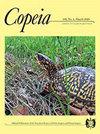热带干旱森林中三种同域龟的形态、性能和生态学
IF 2.6
Q2 Agricultural and Biological Sciences
引用次数: 1
摘要
群落中的资源分配通常是由具有不同形态的同域物种实现的,这使得它们能够获得不同的资源。这是因为形态上的差异会影响生物体执行与其生态相关的任务的能力。在这里,我们比较了三个物种(Rhinoclemmys rubida, R. pulcherrima和Kinosternon chimalhuaca)的肢体、壳和头部形态、游泳性能、栖息地利用和饮食,这些物种共同生活在墨西哥Jalisco州Chamela的热带干燥森林中。我们发现这些物种在栖息地和饮食上都没有重叠,我们在栖息地观察到的重叠与饮食的差异形成对比。我们还发现了肢壳形态、游泳速度和栖息地之间的一致关系。rubida Rhinoclemmys rubida生活在最干燥的落叶林中,栖息在山顶和山坡上,手较短,趾间蹼较少,蹼较长,壳较圆,与体型成比例的游动速度较慢。相比之下,奇诺斯特农金马华卡只栖息在河流或季节性溪流中,它们的手更长,蹼间更多,蹼更小,壳更少,与体型成比例的游动速度更快。pulcherrima在所有栖息地都有发现,在形态和游泳速度上介于其他两个物种之间。因此,在本研究系统中,肢和壳形态是反映龟种生境差异的良好指标。这些差异可能是由于肢和壳形态对游泳表现的影响。头部形态和饮食之间的关系不太清楚,这可能是行为或栖息地变化的结果,而不是形态的变化。Chamela的资源分配模式似乎与其他海龟群落的研究相吻合,这表明我们在这里观察到的形态、性能和生态之间的关系可能是海龟的一般模式。本文章由计算机程序翻译,如有差异,请以英文原文为准。
Morphology, Performance, and Ecology of Three Sympatric Turtles in a Tropical Dry Forest
Resource partitioning in communities is often achieved by sympatric species having different morphologies that allow them to access different resources. This is because differences in morphology influence an organism's capability to perform a task that is relevant to their ecology. Here, we compare limb, shell, and head morphology, swimming performance, habitat use, and diet of three species (Rhinoclemmys rubida , R. pulcherrima, and Kinosternon chimalhuaca) that co-occur in the tropical dry forest of Chamela, Jalisco, Mexico. We found that these species do not overlap in both habitat or diet, and the overlap that we observed in habitat was contrasted by differences in diet. We also found a consistent relationship among limb and shell morphology, swimming speed, and habitat. Rhinoclemmys rubida occupies the driest deciduous forest atop and along hills, has shorter hands, less interdigital webbing, longer plastrons, more-domed shells, and slower swimming speeds in proportion to body size. In contrast, Kinosternon chimalhuaca exclusively occupies arroyos or seasonal streams, has longer hands, more interdigital webbing, smaller plastrons, less-domed shells, and faster swimming speeds in proportion to its body size. Rhinoclemmys pulcherrima was found in all habitats and intermediate in morphology and swimming speed between the other two species. Therefore, in this study system, limb and shell morphology are good indicators of habitat differences between turtle species. These differences are likely due to the influence that limb and shell morphology have on swimming performance. Relationships between head morphology and diet were less clear, which might be the result of changes in behavior or habitat rather than morphology. Patterns of resource partitioning in Chamela seem to coincide with other studies of turtle communities, which suggests that relationships among morphology, performance, and ecology that we observe here might be a general pattern across turtles.
求助全文
通过发布文献求助,成功后即可免费获取论文全文。
去求助
来源期刊

Copeia
生物-动物学
CiteScore
2.10
自引率
0.00%
发文量
0
审稿时长
6-12 weeks
期刊介绍:
Founded in 1913, Copeia is a highly respected international journal dedicated to the publication of high quality, original research papers on the behavior, conservation, ecology, genetics, morphology, evolution, physiology, systematics and taxonomy of extant and extinct fishes, amphibians, and reptiles. Copeia is published electronically and is available through BioOne. Articles are published online first, and print issues appear four times per year. In addition to research articles, Copeia publishes invited review papers, book reviews, and compiles virtual issues on topics of interest drawn from papers previously published in the journal.
 求助内容:
求助内容: 应助结果提醒方式:
应助结果提醒方式:


